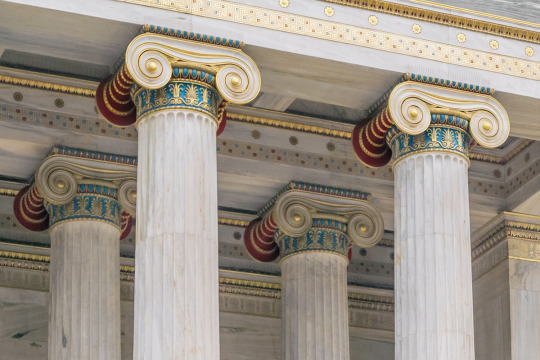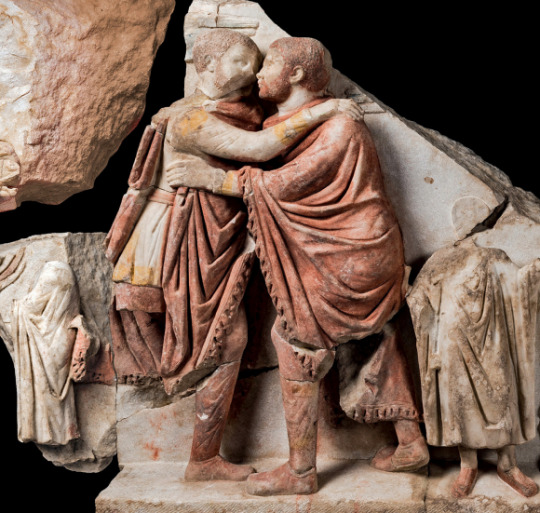#polychromie
Text

[link to tweet]
685 notes
·
View notes
Text

Saint Ursula and her Handmaidens (c. 1525-1530) by Anonymous, oak with polychromy, h 98cm × w 61cm × d 33cm × w 47.2kg, Rijksmuseum, Amsterdam
#saint ursula and her handmaidens#anonymous#rijksmuseum#amsterdam#saint#martyr#martyrs#statue#oak with polychromy#my upload#art#fine art
89 notes
·
View notes
Text


The Reims Stela (Autel de Reims) is one of the more impressive and complete survivals of Cernunnos iconography.
Because the weathered stone is so dull, I've always wanted to see it restored to its former polychromy glory — so I experimented with some digital colorization!
#reims#cernunnos#polychromy#polytheism#paganism#gaulish#horned god#mercury#apollo#aedicula#pagan altar#gaulish polytheism#roman polytheism
37 notes
·
View notes
Text

genuinely so stoked i was able to snatch this up from thriftbooks today at such a decent price (it’s currently for sale on other sites for between $250-300). i went to this exhibition like 6-7 years ago and for some dumbass reason i didn’t buy the book and i’ve been kicking myself for it ever since because it’s been so difficult to find. anyway yeah this little art history nerd is pleased :)
12 notes
·
View notes
Text

DID YOU KNOW?
Ancient Roman statues weren't white as we see them today but were actually colorful.
Roman artists used a wide range of pigments, painting media, and surface applications to embellish their marble sculptures.
In the 19th century, archaeologists unearthed better-preserved items that had traces of color.
But these were mostly ignored — and often actively scrubbed off — until as late as the 1960s.
It was only then that scholars began to confirm that the white sculptures we all associated with Ancient Greece and Rome were actually painted with multiple colors — a practice known as polychromy.
The paint had deteriorated and faded over time, but evidence of it remained.
—

📷: Observeculture_ via X
Gallo-Roman Museum (Tongeren, Belgium)
9 notes
·
View notes
Photo

Vinzenz Brinkmann and Ulrike Koch-Brinkmann, reconstruction of the so-called Chios Kore from the Athenian Acropolis (2012),
Marble stucco on polymethyl methacrylate, natural pigments in egg tempera.
Courtesy Liebieghaus Skulpturensammlung (Liebieghaus Polychromy Research Project), Frankfurt am Main; original: Greece, Athens, marble, c. 520–500 BCE, Acropolis Museum, Athens.
The Met’s latest exhibition on Greek and Roman art brings color back to whitewashed ancient sculptures by analyzing “polychromy,” or the rhetorical uses of color. Employing 3D imaging techniques, curators developed new restorative methods to simulate how ancient works appeared in their time, placing reproductions alongside originals to exemplify the aging process.
The Metropolitan Museum of Art (metmuseum.org)
1000 Fifth Avenue, Upper East Side, Manhattan
Through March 26, 2023
#art#sculpture#colors#polychromy#reconstruction#chios kore#Athens#greece#history#style#themet#marble#stucco#restauration#vinzenz brinkmann#ulrike koch-brinkmann
85 notes
·
View notes
Text
Author & Timestamp:
Margaret Talbot
October 22, 2018 (almost 6 years old as of May 2, 2024)
Polychromy refers to "decoration in many colours, esp in architecture or sculpture". - Collins Dictionary.
Extract of a much longer article
(please note: I have shortened some sentences where possible and broken up some paragraphs by added spacing. I did this to try to make it a little easier for other neurodivergent people to read):

Researchers demonstrate the process of applying color to the Treu Head, from a Roman sculpture of a goddess, made in the second century A.D. Ancient sculptures were often painted with vibrant hair colors and skin tones. - Photograph by Mark Peckmezian for The New Yorker
For Abbe, [...] a professor of ancient art at the University of Georgia, the idea that the ancients disdained bright color “is the most common misconception about Western aesthetics in the history of Western art.” It is, he said, “a lie we all hold dear.”
[...]
[...] Marco Leona, who runs the scientific-research department at the Metropolitan Museum of Art [...] said, of polychromy, “It’s like the best-kept secret that’s not even a secret.”
Jan Stubbe Østergaard, a former curator at the Ny Carlsberg Glyptotek museum, in Copenhagen, and the founder of an international research network on polychromy, told me, “Saying you’ve seen these sculptures when you’ve seen only the white marble is comparable to somebody coming from the beach and saying they’ve seen a whale because there was a skeleton on the beach.”
[...]
[...] debate about ancient sculpture has taken on an unexpected moral and political urgency. [In 2017], a University of Iowa classics professor, Sarah Bond, published two essays [...] arguing that it was time we all accepted that ancient sculpture was not pure white—and neither were the people of the ancient world. One false notion, she said, had reinforced the other.
For classical scholars, it is a given that the Roman Empire—which, at its height, stretched from North Africa to Scotland—was ethnically diverse. In the Forbes essay, Bond notes, “Although Romans generally differentiated people on their cultural and ethnic background rather than the color of their skin, ancient sources do occasionally mention skin tone and artists tried to convey the color of their flesh.”
Depictions of darker skin can be seen on ancient vases, in small terra-cotta figures, and in the Fayum portraits, a remarkable trove of naturalistic paintings from the imperial Roman province of Egypt, which are among the few paintings on wood that survive from that period. These near-life-size portraits, which were painted on funerary objects, present their subjects with an array of skin tones, from olive green to deep brown, testifying to a complex intermingling of Greek, Roman, and local Egyptian populations. (The Fayum portraits have been widely dispersed among museums.)
Bond [had] been moved to write her essays when a racist group, Identity Evropa, started putting up posters on college campuses, including Iowa’s, that presented classical white marble statues as emblems of white nationalism. After the publication of her essays, she received a stream of hate messages online. She is not the only classicist who has been targeted by the so-called alt-right. Some white supremacists have been drawn to classical studies out of a desire to affirm what they imagine to be an unblemished lineage of white Western culture extending back to ancient Greece. When they are told that their understanding of classical history is flawed, they often get testy.
[In early 2018], the BBC and Netflix broadcast “Troy: Fall of a City,” a miniseries in which the Homeric hero Achilles is played by a British actor of Ghanaian descent. The casting decision elicited a backlash in right-wing publications. Online commenters insisted that the “real” Achilles was blond-haired and blue-eyed, and that someone with skin as dark as the actor’s surely would have been a slave.
It’s true that Homer describes the hair of Achilles as xanthos, a word often used to characterize objects that we would call yellow, but Achilles is [mythological], so imaginative license in casting seems perfectly acceptable. Moreover, several scholars explained online that, though ancient Greeks and Romans certainly noticed skin color, they did not practice systematic racism. They owned slaves, but this population was drawn from a wide range of conquered peoples, including Gauls and Germans.
Nor did the Greeks conceive of race the way we do. [...] Rebecca Futo Kennedy, a classicist at Denison University, who writes on race and ethnicity, told me, “Cold weather made you stupid but also courageous, so that was what people from the Far North were supposed to be like. And the people they called Ethiopians were thought of as very smart but cowardly. It comes out of the medical tradition [of the Hippocratic humours]. In the North, you have plenty of thick blood. Whereas, in the South, you’re being desiccated by the sun, and you have to think about how to conserve your blood.”
Pale skin on a woman was considered a sign of beauty and refinement, because it showed that she was privileged enough not to have to work outdoors. But a man with pale skin was considered unmasculine: bronzed skin was associated with the heroes who fought on battlefields and competed as athletes, naked, in amphitheatres.
[...] Tim Whitmarsh, a professor of Greek culture at the University of Cambridge, writes that the Greeks “would have been staggered” by the suggestion that they were “white.” Not only do our modern notions of race clash with the thinking of the ancient past; so do our terms for colors, as is clear to anyone who has tried to conceive what a “wine-dark sea” actually looked like.
[...]
On the website Pharos, which was founded [...] in part to counter white-supremacist interpretations of the ancient world, a recent essay notes, “Although there is a persistent, racist preference for lighter skin over darker skin in the contemporary world, the ancient Greeks considered darker skin” for men to be “more beautiful and a sign of physical and moral superiority.”
[In 2017], high-school students participating in a summer program at the RISD Museum, in Providence, were so fascinated to learn about polychromy in classical statuary that they made a coloring book allowing gallery visitors to create brightly hued versions of the objects on display.
Christina Alderman, who runs the program, told me, “The moment they found out that the statues were originally painted, I just lost them to that idea. They were, like, ‘Wait, are you serious? I’ve played video games set in ancient times, and all I see are white sculptures. I watch movies and that’s all I see.’ It was a real human response—they kind of felt they’d been lied to.”

A marble head of a deity wearing a Dionysiac fillet, from the first century A.D. Traces of red pigment remain on the lips, eyes, and fillet. Marco Leona, who runs the scientific-research department at the Metropolitan Museum of Art, said the fact that ancient statues were once painted is “like the best-kept secret that’s not even a secret.” - Courtesy Metropolitan Museum of Art

A bust of a young African boy, sculpted in the first century B.C. Ancient sculptures of African people were often made of basalt and painted with reddish-brown layers to create a lifelike effect. Mahogany-colored paint is still visible on the boy’s face. - Courtesy Museum für Kunst und Gewerbe Hamburg
/endofextract
[I edited this blog post to provide a definition of polychromy and fix a couple of typos. - May 3, 2024]
#classical studies#history#ancient#ancient history#antiquity#classical antiquity#The New Yorker#polychromy#museum politics#museum problems#classical history#classical rome#classical greece#ancient greece#ancient greek#archaic greece#greek antiquity#greek sculpture#Greek and Roman sculpture#ancient sculpture#white supremacy#older article#article#art history#art galleries#muesums#racism#european history
3 notes
·
View notes
Text

Woman from the colonies, Charles Cordier, 1861, marble and onyx, Musée d'Orsay, Paris.
27 notes
·
View notes
Text

Morellet - Violet, bleu, vert, jaune, orange, rouge - 1953
#François Morellet#art#1950s#french art#violet#contemporary art#abstraction#geometrical abstraction#cross#optical art#polychromy
3 notes
·
View notes
Text


When we talk about ancient #polychromy, we're not only referring to paint. We're also talking about *gold*, as seen in this well-preserved 1st c. CE head of a young man. Red in the hair, black in the eyes and brows, and gold all over the face. Perhaps Apollo?
—Chapps on twitter, Nov 5 2022 (source)
24 notes
·
View notes
Note
I check your blog for Aypierre update (i dont have time at all to watch the streams/vod), and i speak french so if you need any help translating/understanding something, feel free to send me a DM and i'll be happy to help you :D (you can send it to this blog or my mineblr decorative-polychromy)
ah tysm! ive mostly been getting by with the in game translator and context clues but i may take you up on that eventually :D
3 notes
·
View notes
Text

Time's running-WIP- 2022
#my art#traditional art#red and blue#pencil art#momento mori#polychromy#anaglyph#finally posting some art again
7 notes
·
View notes
Text












Last weekend was pretty busy because the weather was nice and I wanted to take as many photos as I could. There was an event called Matsuri (dedicated to Japanese culture) so I decided to pop in. It used to be an annual event so it was pretty much the same as few years ago. That's why I only have some photos from the samurai armour exhibition. Then I was roaming around the city taking photos of architecture and some street art. I just wish time didn't fly like crazy during my days off.
1 note
·
View note
Text

0 notes
Photo




Happy Friday! We love colorful architecture, modern and ancient! Polychromy, color in ancient architecture and sculpture, was first discovered in the 19th century, and it is still startling. Buildings from the late 19th and early 20th often show classical architecture as it might once have looked: the Academy of Athens (Hansen, 1859) and the Philadelphia Museum of Art (Trumbauer, 1916-28). For the dubious, actual paint remnants on a Roman relief from Nicomedia (2nd century)!
1 note
·
View note
Photo




Happy Friday! We love colorful architecture, modern and ancient! Polychromy, color in ancient architecture and sculpture, was first discovered in the 19th century, and it is still startling. Buildings from the late 19th and early 20th often show classical architecture as it might once have looked: the Academy of Athens (Hansen, 1859) and the Philadelphia Museum of Art (Trumbauer, 1916-28). For the dubious, actual paint remnants on a Roman relief from Nicomedia (2nd century)!
0 notes